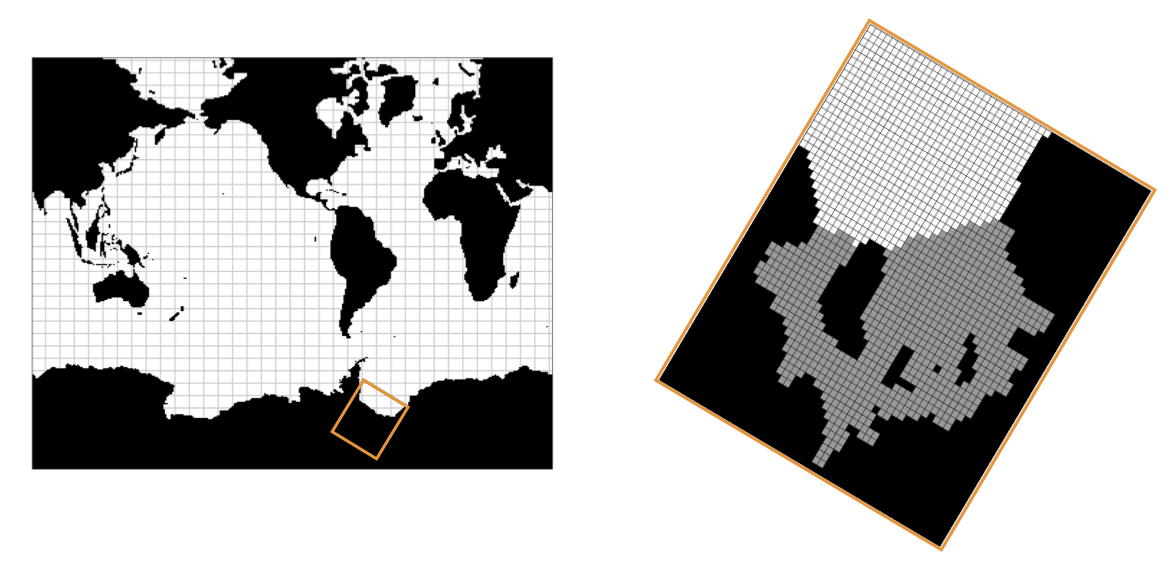Models to travel through space and time
In the history of the study of extreme events, as in that of the climate, one tool has rapidly proved indispensable. Able to synthesise a virtual replica of our planet, models allow researchers to observe the behaviour of its various components, (almost) without the use of measuring instruments.

Illustration of an example of an oceanic model : on the left to represent the global ocean in future climate projections (a square represents 10×10 points of the model), on the right to study the oceanic circulation under the Antarctic ice sheet in Weddell Sea (the ice sheet in grey, 1 square represents 1 point of the model). In both illustrations, the ocean is in white and the land is in black.
Bottling up the Earth, being able to explore its past and future states, moving around without limits and playing with the multiple variables of its climate system: over the course of history, this climatologist’s dream has rapidly become an essential requirement to the study of the Earth’s climate. If the bottle gives way to a more sophisticated container, the computer, the digital replica takes the form of climate models. These powerful tools enable researchers to fill in gaps beyond what observations can see. “It is sometimes possible to verify the existence of a phenomenon directly, but in the case of past and future climates, the data no longer exists, or is yet to come”, explains Julie Deshayes, oceanographer at the LOCEAN laboratory of the IPSL.
In some cases, the difficulty of collecting data means that models are the only way to study a phenomenon. Julie Deshayes works on deep currents and their influence on climate. In her line of study, the use of models is key: “The currents I study are very intense but difficult to observe and as a result, the study of their evolution over long periods of time relies heavily on the use of numerical tools”, she adds. “Satellite data collection allows us to obtain a huge quantity of continuous points, but it only gives information on the surface of the oceans.”
From equations to data
Unlike those used in other fields, climate models do not start from existing data but from equations that must be resolved. Be it water flowing out of a jug or the movement of gases in the atmosphere, the equations at play are the ones governing the physics of fluids. “The hitch with these equations is their complexity, they require large simplifying assumptions to be solved by a computer”, mentions Julie Deshayes. It is then primordial to check that simplifications do not affect the reliability of the model, and this is where data gets involved: “Once the equations are solved, we can compare the results with direct observations, that is if we have some.” If the model is too far from reality ─ or in the absence of data, from the results of other models ─ the simplifying assumptions are changed until it is deemed sufficiently reliable. But is it possible, through repeated improvements, to obtain such an accurate representation of the system that we can anticipate and understand every internal movement, past and future?
For Julie Deshayes, there is no ambiguity: “the climate system has a degree of unpredictability that is impossible to reproduce virtually. Depending on the subject, the modeller allows himself a margin of acceptability: that is where his expertise lies. There is not one model that is good for everything, there are several models to answer several scientific questions.” Far from being an immutable and universal tool, modelling is a science in itself, granting researchers the power to put each world in a unique bottle.
Translated from Marion Barbé for IPSL
To go further
Discover Mozaïka: Did you say extreme?






